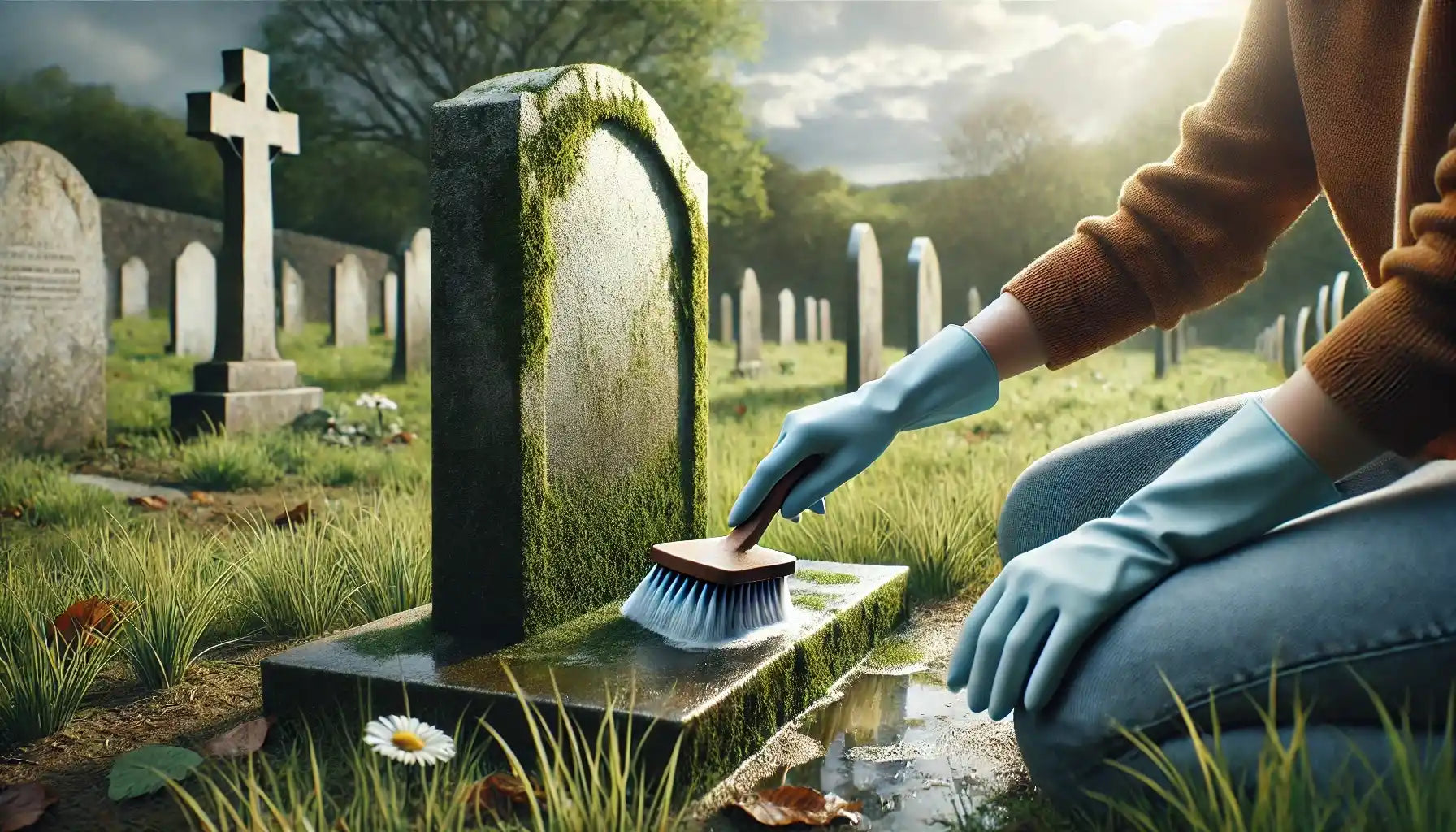Over time, even the most well-crafted stones can succumb to the elements. Dirt, moss, lichen, and pollution don’t just dull the appearance, they can cause lasting damage if left untreated.
If you've ever visited a loved one’s grave and noticed the headstone looking worn, stained, or covered in buildup, don’t worry, you can restore it with the right techniques. However, using the wrong cleaning methods can do more harm than good.
In this guide, you’ll learn exactly how to clean a headstone safely and effectively, step by step. Whether it’s granite, marble, or bronze, We’ll walk you through the best cleaning techniques, the must-have supplies, and the common mistakes to avoid. By the time you're done, you’ll have a beautifully restored headstone without damaging its surface or historical integrity.

Common Headstone Materials and Their Characteristics
Before cleaning, it’s important to identify the type of material, as each requires a different approach. Before you even think about grabbing a brush and a bottle of cleaner, you need to understand what you’re working with. Cleaning the wrong way can lead to permanent damage, and in some cases, you might accelerate the decay you’re trying to prevent. Let’s break down the most common headstone materials, their unique properties, and what that means for cleaning and maintenance.
Granite – The Workhorse of Headstones
Granite is hands-down the most popular material for modern headstones, and for good reason. It’s tough, non-porous, and can handle exposure to the elements better than most other materials. Rain, snow, and extreme temperatures? No problem. Granite shrugs them off with ease.
What This Means for Cleaning
-
You can use mild detergents (like dish soap diluted in water) without worrying about damage.
-
A soft-bristle brush is safe to use: granite can handle a bit of scrubbing.
-
Stubborn stains, like lichen or mold, may need a bit of patience, but they usually come off with a mix of water and a non-ionic detergent.
-
Harsh chemicals, like bleach or acid-based cleaners, should be avoided. They can weaken the stone’s surface over time.
Marble – Beautiful but High Maintenance
Marble has a classic, elegant look, but that beauty comes at a cost. It’s a softer stone and much more porous than granite, which absorbs water and is vulnerable to erosion. Over time, exposure to acidic rain and pollution can wear down the details, causing inscriptions and decorative elements to fade.
What This Means for Cleaning
-
Always go with the gentlest cleaning methods: rough scrubbing can accelerate wear.
-
Use water and a soft-bristle brush; avoid wire brushes or anything abrasive.
-
If necessary, a small amount of a pH-neutral, non-ionic detergent can be used, but never anything acidic.
-
Avoid pressure washing at all costs: it can strip away the delicate surface.
-
If the marble headstone is already showing signs of erosion, consider consulting a professional rather than attempting to clean it yourself.
Limestone & Sandstone – The Fragile Twins
Limestone and sandstone are among the most delicate headstone materials. These stones are highly porous, which means they soak up water like a sponge. Over time, moisture can lead to internal breakdowns, causing the stone to flake and crumble. Once that starts, there’s no reversing it.
What This Means for Cleaning
-
Water is your safest bet, so avoid detergents and soaps altogether.
-
A soft-bristle brush is fine but never scrub aggressively. These stones are highly susceptible to wear.
-
If there’s significant biological growth (like moss or lichen), don’t try to scrape it off. Instead, dampen the area and gently remove it with a soft sponge.
-
Avoid commercial cleaning products, even those labeled “safe for stone”, as these materials are too delicate.
-
Keep in mind that sandstone, in particular, is prone to delamination, where layers of the stone start to peel away. If you notice this happening, stop cleaning immediately and consult a specialist.
Bronze – The One That Ages with Style
Unlike stone headstones, bronze doesn’t erode, but it does develop a patina over time. This natural oxidation process creates a greenish-brown layer that some people love and others want to remove. The challenge with bronze is that it’s metal, meaning exposure to the elements can lead to corrosion if not maintained properly.
What This Means for Cleaning
-
If you like the patina, leave it alone! It’s a natural protective layer.
-
If you want to restore the shine, use a bronze cleaner specifically designed for the material, never use generic metal polish, as it can strip protective coatings.
-
A soft cloth or sponge is best for cleaning, avoid anything abrasive that could scratch the surface.
-
After cleaning, applying a thin layer of paste wax can help protect against future oxidation.
Essential Tools & Supplies
Whether you're tending to a loved one’s resting place or restoring an old, forgotten marker, using the right tools and supplies is important. The wrong approach can cause lasting damage, so let's break down what you need and what you should absolutely avoid.

Soft-bristled brushes (natural or nylon) – Harsh scrubbing is a no-go. A soft-bristled brush allows you to clean without scratching the stone. Natural or nylon bristles are best for lifting dirt without wearing down the material.
Spray bottles for controlled water application – A bucket might seem convenient, but too much water can lead to streaking or water absorption in porous stones. A spray bottle helps you control the amount of moisture.
Non-ionic soap (D/2 Biological Solution or Orvus WA Paste) – This is what separates real headstone care from DIY disasters. Non-ionic soaps effectively clean biological growth like moss and lichen without leaving harmful residues. D/2 is a favorite among professionals for a reason—it works.
Distilled water – If you're cleaning limestone, marble, or sandstone, always use distilled water. Minerals in tap water can leave stains or react with the stone over time.
Wooden or plastic scrapers – For lichen, moss, or built-up grime, avoid metal tools at all costs. Wooden or plastic scrapers let you remove stubborn debris without leaving scratches.
Lint-free cloths or microfiber towels – After cleaning, drying the headstone properly is just as important as washing it. Microfiber towels guarantee that no lint, fibers, or streaks are left behind.
Gloves – Whether you're using cleaning solutions or simply handling old stones, gloves protect both your hands and the headstone. Oils from your skin can stain some stone types over time.
These aren’t just suggestions, they’re non-negotiables if you want to preserve the headstone styles and keep them looking their best for years to come.
Cleaning Products to Avoid
If you think a quick wipe-down with household cleaners will do the job, think again. Some products might seem effective at first, but they can cause lasting damage. Here’s what to never use:
Bleach or ammonia-based cleaners – These might seem like easy solutions for killing moss or mold, but they can cause staining, streaking, and even weaken the stone’s structure over time.
Power washers – High-pressure water might be great for sidewalks, but it’s too aggressive for headstones. It can erode softer stones and force water into cracks, accelerating deterioration.
Wire brushes or metal scrapers – These tools are far too abrasive. They can create micro-scratches, making the stone more vulnerable to dirt and water damage.
Household dish soaps with dyes or perfumes – They may smell nice, but they often leave behind residues that attract more dirt and moisture, defeating the purpose of cleaning in the first place.
Taking quick fixes with the wrong products will only lead to more headstone restoration work down the line. A proper cleaning job should preserve, not accelerate wear and tear.
Having the right tools and avoiding harmful products makes all the difference in keeping a headstone clean without causing headstone damage. Treating the stone with care guarantees that it remains a respectful, lasting tribute for generations.
Step-by-Step Cleaning Process
Now, we’ll walk you through the entire process, step by step, with adjustments for different materials. Whether you're visiting a headstone store near you for supplies or simply maintaining a loved one’s memorial, following the right process guarantees the stone remains in great condition for years to come.
Prepare the Area
Before touching the headstone, take a moment to clear the surrounding space. Remove any leaves, dirt, or overgrown grass to prevent debris from getting stuck in the cleaning process.
Never go straight in with cleaning solutions, especially on older or delicate headstones. Saturating the stone with clean water first helps prevent cleaning agents from being absorbed too quickly, which can cause damage over time. If the headstone is dry, porous materials like limestone or sandstone can absorb soap or chemicals, leading to staining or weakening.
Use distilled water whenever possible, especially for softer stones like marble and limestone. Hard water can leave mineral deposits that contribute to erosion.
Cleaning Process for Different Materials
Each headstone material has different care requirements. What works for granite may ruin marble, and bronze requires extra steps for preservation.
Granite Headstone Cleaning: Granite is one of the most durable materials, but that doesn’t mean it’s indestructible. Here’s the safest and most effective way to clean it:
Thoroughly wet the surface with clean water. If the headstone is large and heavy (check out how much a headstone weighs if you're unsure), use a spray bottle or a low-pressure hose. Avoid household cleaners, as they can cause discoloration. Instead, use a mix of water and a gentle stone-cleaning soap.
Next, use a soft-bristle brush (never wire brushes) to avoid scratching the surface. Pay extra attention to engraved areas where dirt accumulates. Remember, soap residue can attract more dirt over time, so make sure every trace is removed.
At the end, dry with a microfiber cloth to prevent water spots from forming. If you're considering buying a headstone, granite is a great long-term choice because it’s so resistant to weathering and stains.
Marble, Limestone, or Sandstone Cleaning: These materials are much softer than granite and require extra care to avoid damage. Over time, they naturally wear down, which means harsh scrubbing or chemicals can accelerate deterioration.
First of all, start with distilled water. Soak the headstone thoroughly to reduce its porosity before cleaning. Then, gently remove surface dirt. Use a soft brush and light pressure. Never scrub aggressively, if the dirt isn’t coming off easily, let the water soften it instead of forcing it.
We’d highly recommend using non-ionic soap sparingly. If additional cleaning is needed, apply a small amount of work in light circular motions, and rinse with distilled water.
It’s important to let it air dry naturally. Do not wipe with a cloth, as this can trap lint and create streaks. If you're wondering about headstone cost, marble, and limestone are often pricier due to their aesthetic appeal but require more maintenance compared to granite.
Bronze Headstone Cleaning: Bronze headstones develop a patina over time: a natural greenish or brownish layer. Some people prefer this aged look, but if you want to restore the shine, follow these steps:Use distilled water and a mild soap solution. Avoid harsh chemicals that can strip the protective layer.
Apply with a soft cloth, using circular motions. Do not use abrasive brushes, as they can scratch the surface.
Rinse and dry thoroughly. Bronze is prone to water stains, so ensure it's completely dry before finishing.
Apply a bronze wax or UV protectant. This helps maintain the shine and slows down oxidation.
How to Prevent Future Buildup & Damage
Cleaning a headstone is only half the battle. If you want it to stay in good condition for years, you need a solid strategy to prevent buildup and damage. Headstones are designed to hold out against the elements, but they’re still vulnerable to mold, lichen, pollution, and even human impact. Here’s how to give them the best possible protection.

Choose the Right Cleaning Routine
Regular maintenance is the key to keeping a headstone looking pristine. Even if it doesn’t look dirty, cleaning it gently every 6 to 12 months prevents buildup from becoming stubborn or damaging the stone. Different materials require different approaches:
-
Granite & Marble: Clean every 6-12 months to prevent lichen and staining.
-
Sandstone & Limestone: These are porous stones, so a light cleaning every 4-6 months helps prevent deep staining and erosion.
-
Bronze Markers: These need both cleaning and waxing every 6 months to prevent oxidation.
The trick is to clean before the buildup becomes a problem, rather than after it’s already stained the stone.
Trim Nearby Vegetation
Overgrown grass, vines, and tree branches don’t just make a headstone look neglected, they contribute to long-term damage. Moisture from leaves and grass can encourage moss growth, while tree roots can cause cracks or tilting.
Here’s what you should do:
-
Keep grass trimmed at least a few inches away from the base.
-
Remove vines and ivy that climb onto the stone: they trap moisture and speed up decay.
-
Avoid planting trees too close—roots can shift the foundation over time.
A clear perimeter around the headstone will keep moisture and plant-related damage in check.
Apply a Stone-Safe Sealant (If Appropriate)
Not every headstone should be sealed. Some materials, like granite, are naturally resistant to moisture, while softer stones (like sandstone and limestone) need to “breathe.” If sealed incorrectly, these porous stones can trap moisture inside, leading to more damage.
If you’re considering a sealant, keep these rules in mind:
-
Granite: Generally doesn’t need a sealant, but if used, it must be breathable.
-
Marble: Not recommended—trapping moisture inside can cause deterioration.
-
Limestone & Sandstone: Special breathable sealants can help reduce moisture absorption.
Consult a professional before applying any sealant. If you do it incorrectly, it can cause more harm than good.
Control Water Runoff
Water is one of the biggest culprits behind headstone erosion. Rainwater, especially if acidic (common in urban areas), slowly wears down the stone, creating rough patches and stains.
To minimize damage:
Check for pooling water around the base after heavy rain. If water collects, consider adding small drainage stones or improving the soil’s drainage.
Avoid sprinklers aimed directly at the headstone. Hard water stains and minerals in tap water can leave behind white deposits.
Gently dry the stone after cleaning to prevent standing water from settling in crevices.
Use a Soft-Bristle Brush for Routine Maintenance
Many people make the mistake of scrubbing a headstone too aggressively or using metal brushes, which can scratch the surface. Over time, even minor scratches weaken the stone and make it more vulnerable to dirt and moisture.
Instead, stick with soft-bristle brushes (like toothbrushes or natural fiber brushes) and always scrub in circular motions rather than back and forth. This prevents unnecessary wear.
For bronze markers, apply a protective coat of paste wax after cleaning to slow oxidation and preserve the metal’s finish.
Monitor for Small Cracks & Wear
Cracks in a headstone aren’t just cosmetic; they’re early warning signs of serious deterioration. Small cracks allow water to seep in, which expands and worsens the damage during freezing temperatures.
Every time you visit, take a moment to check for:
-
New cracks or chips (especially on edges and engravings).
-
Fading inscriptions (a sign of erosion).
-
Shifts in position (which could indicate a loose foundation).
Catching these issues early makes a huge difference in preservation. If you notice significant damage, consult a professional conservator before it worsens.
Protect Against Harsh Weather
If the headstone is in an area with extreme temperatures, it may need extra care.
Winter Freeze Protection: If the cemetery allows, cover the base with mulch or gravel to reduce frost heaving (where the stone shifts due to frozen ground).
Summer Heat Precautions: Direct sunlight can cause some stones to fade over time. If possible, plant small shade-providing bushes at a safe distance to reduce UV exposure.
If a headstone is old or belongs to an ancestor, preserving its history is just as important as maintaining its appearance. So, take before and after photos when cleaning and track any changes over time. Consider recording inscriptions digitally in case of future wear.
The Bottom Line
Whether it’s a family member, a friend, or even a forgotten marker in an old cemetery, every stone tells a story. Taking the time to clean it properly, and using the right tools and techniques, guarantees that the story remains clear for generations to come.
But patience is key. Harsh chemicals or aggressive scrubbing might offer instant results, but at what cost? Damage from improper cleaning is irrecoverable. Approach the process with care, using gentle, proven methods that clean without harming.


